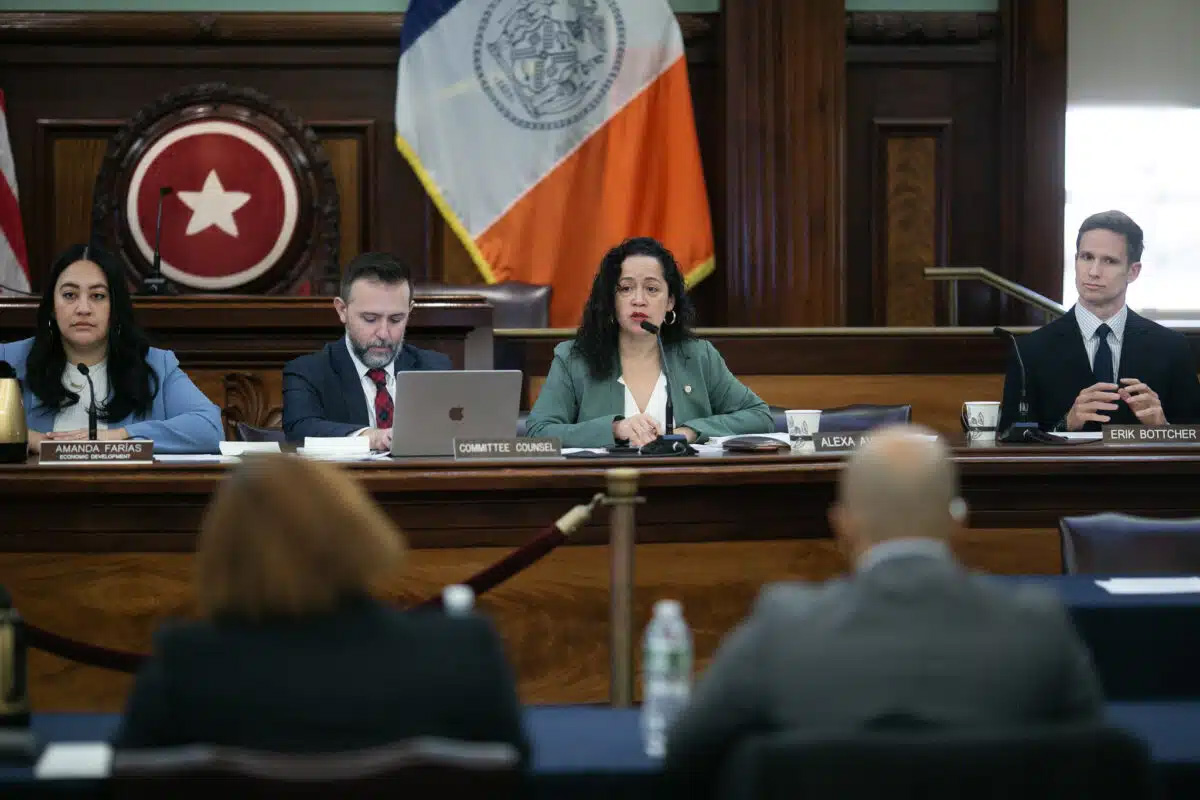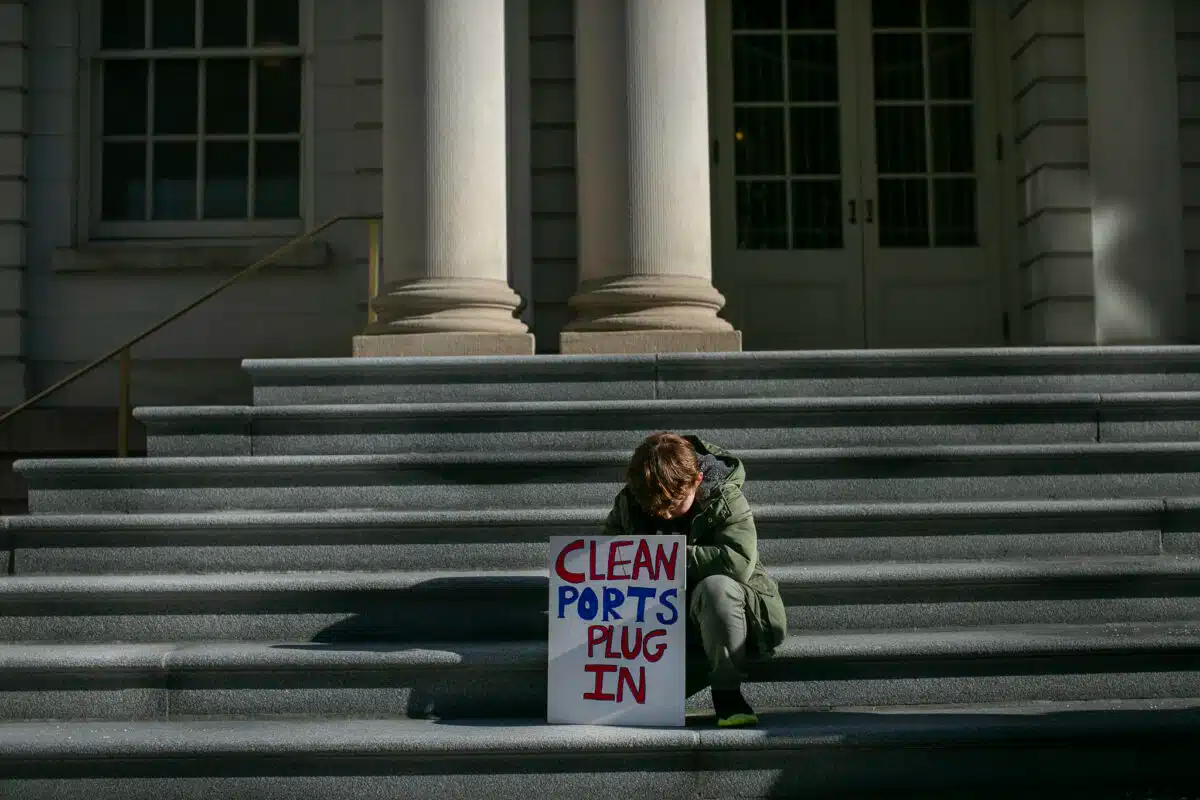Bill Could Force Red Hook's Idling Diesel-Powered Cruise Ships to Connect to Shore Power
Fossil fuel-emitting cruise ships would have to exit New York City ports unless they plug into clean shore power for energy, should a bill in the City Council become law.

Mayor Eric Adams pointed at the MSC Seascape cruise ship. Wednesday, December 7, 2022. Photo by Michael Appleton/Mayoral Photography Office
By Ben Brachfeld, amNY
Fossil fuel-emitting cruise ships would have to exit New York City ports unless they plug into clean shore power for energy, should a bill in the City Council become law.
Intro. 4 of 2024, sponsored by Democratic City Council Members Alexa Avilés of Brooklyn and Erik Bottcher of Manhattan, would condition access to the city’s two cruise ports — located in the sponsors’ districts in Red Hook and Hell’s Kitchen — exclusively to operators that both connect to the electric grid instead of burning fossil fuels for power when in berth and create plans to mitigate traffic associated with cruise departures.
Over 1.3 million passengers embarked on cruises out of the Manhattan and Brooklyn terminals last year, bringing in about $420 million in economic activity to the city, according to the Economic Development Corporation (EDC), the quasi-public agency that oversees the city’s cruise terminals and ferry landings.
But especially in Red Hook, locals say they are not feeling the benefits, only the downsides. When cruise ships berth in a harbor and don’t connect to shore power, they idle to retain power — burning diesel fuel in the process.
Due to their immense size, just one cruise ship idling in port emits as much carbon into the atmosphere as more than 34,000 heavy-duty trucks, the bill’s sponsors say, plus large amounts of noxious sulfur dioxide.
What’s more, cruise ships also draw large amounts of traffic from trucks supplying food, booze, and other goods aimed at creating a fantasy vacation for guests. Many ocean goers also arrive at the terminal by car, creating a traffic nightmare in Red Hook each time a ship is in dock.
Partially as a result of the cruises, both Council Districts 3 and 38, where the terminals are located, have above-average levels of air pollution compared to the city overall, according to Spatial Equity NYC. That’s particularly felt in Red Hook, where some residents see cruises as purely “extractive” without contributing to the community’s wellbeing.
“What we’re saying here is that the health of all New Yorkers should be the city’s first priority,” Avilés said at the hearing. “The Red Hook community has not seen economic benefit from this or any other cruise deal…we have seen a negative benefit, and that is traffic, unwieldy, businesses closing because workers can’t get there, honking, car crashes.”
Limits to ship power on shore
Brooklyn’s cruise terminal opened in 2006, and in 2017, it became the first cruise port on the East Coast to be outfitted with shore power capability. But the terminal’s shore power apparatus was designed specifically for the Cunard Line’s Queen Mary 2 and Princess line ships, and even those only use it about 70 percent of the time. Other ships can’t use it at all.

That’s posed a significant problem since Mayor Eric Adams announced a $100 million deal to bring the MSC Meraviglia, one of the largest ships in the world, to port in Brooklyn year-round. The Meraviglia is over 1,000 feet long and 171,000 gross tons, has space for 5,500 passengers and 2,500 crew, and features 12 restaurants, 20 bars, a waterpark, and a Formula 1 simulator.
What it doesn’t have, however, is a shore power connection calibrated for Brooklyn’s plugin, so the Meraviglia powers itself by spewing fossil fuels into Red Hook’s air, which is also polluted by a concentration of last-mile trucking facilities.
EDC says it expects to install a “mobile jib” by the end of this year that will allow the Meraviglia to connect to shore power.
Ship captains typically prefer to connect to shore power because it is less costly than burning fuel, the agency says. When they can’t, it can typically be blamed on inclement weather or issues with the electrical grid; ships are like a mini-city, and powering a cruise liner can sometimes mean Con Edison must “load shed,” or reduce power to other communities, especially in the summer high season when power demand is greatest.
EDC says it shares the goals of the sponsors of Intro 4, though it contends that it has worked out largely the same terms with the cruise companies in their operating deals while the industry itself has set voluntary targets for shore power capability.
“We absolutely share the Council’s goals of Introduction 4 and are committed to increasing the availability and utilization of shore power at both the Brooklyn and Manhattan cruise terminals, and improving traffic management within those local neighborhoods,” said Sabrina Lippman, senior vice president for portfolio management at EDC, at an oversight hearing on the topic at City Hall on Thursday.
Avilés, however, accused EDC of simply cowing to the cruise companies in adopting the industry’s self-set goal that all ships be equipped with shore power by 2035.
“We work for the residents of New York City, not the cruise line operators that see billions of dollars of revenue that we don’t see any of,” said Avilés. “I think the 2035 deadline is too far out, and benefits the cruise line industry instead of New Yorkers.”
Meanwhile, Manhattan’s cruise terminal, which sees 10 times the passenger traffic as Brooklyn, is not shore power-equipped at all. The EDC is currently undertaking a feasibility study and is almost done with it, needing only a letter from Con Ed on the potential electrical needs.
Whether or not the terminal has the electrical infrastructure to handle shore power now, it would take many years and millions of dollars to equip the Manhattan port with the technology, the agency says.
“These are multi-year and very intensive and complicated projects that would be under way to enable the terminals with shore power,” said Lippman.
A personal issue for Red Hook
Red Hook residents waited a long time for shore power to be fully operational at the Brooklyn terminal, and have been disappointed to see it fail to live up to its potential since being installed. As such, many are advocating for the bill’s passage as a means to force the hand of EDC and the cruise ships.

“My son was 6 years old when the NYC EDC promised to bring life-saving shore power to the Brooklyn Cruise Terminal,” Adam Armstrong, member of Red Hook NY Rising and a longtime advocate for shore power. “That was a result of community activism that was urging the city to do something about the idling ships at the edge of our neighborhood. Today, next month, my son is 21, and that system is still not operating to its full potential and too many ships continue to idle, emitting dirty fossil fuels that harm our community and our planet.”
Armstrong has since left Red Hook, he said, partly due to the intense pollution in the neighborhood caused by the cruise ships and truck traffic.
“We can no longer wait for the New York City Economic Development Corporation to fulfill promises that zero-emission shore power system will be fixed. We can no longer believe multi-billion dollar cruise companies’ vague commitments that they will connect to the system that we, residents and taxpayers, paid for and fought for.”
While Brooklyn was the first East Coast port to be equipped with shore power, the port of Miami — the world’s second-largest cruise port — expects to have a much larger shore power apparatus installed by the end of this year. The port of Seattle has had shore power since 2004. In California, all cruise ships were required to plug into shore power at Golden State ports starting last year, and all ships, including cargo vessels, are required to use it by 2027.
Although the mobile jib to allow shore power connection by the Meraviglia is expected to be done this year, according to EDC, the agency also noted that MSC is only docking at Brooklyn on a temporary basis, and eventually intends to move its port operations to Manhattan. Still, an MSC Cruises spokesperson said the company intends to connect to shore power in Brooklyn as soon as it’s feasible.
“MSC Cruises is deeply committed to prioritizing sustainability and minimizing our environmental footprint,” said MSC spokesperson Sutton Field. “We take great pride in sailing the shore-power equipped MSC Meraviglia from New York City, and our goal is to connect to shore power as soon as the Brooklyn Cruise Terminal is equipped with the capabilities necessary to accommodate all ships.”
The Meraviglia is the only ship using the Brooklyn port in the wintertime. It will berth in Red Hook 10 times through May, including on Sunday, after which other ships will join for the high season like the Queen Mary 2, the Island Princess, and the Silver Explorer.
Editor’s note: A version of this story originally ran in amNY. Click here to see the original story.
Related Stories
- Ideas for the Brooklyn Cruise Terminal
- City to Build Out Climate Innovation Hub for Green Tech at Sunset Park’s Brooklyn Army Terminal
- Climate Change and Warmer Winters Mean More Rain and Flooding in Brooklyn
Email tips@brownstoner.com with further comments, questions or tips. Follow Brownstoner on Twitter and Instagram, and like us on Facebook.








What's Your Take? Leave a Comment